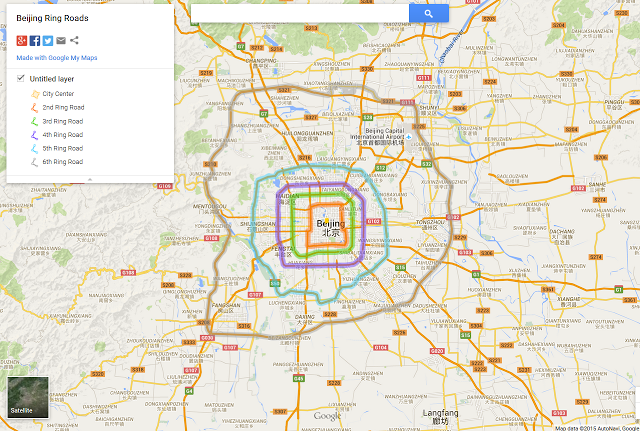Beijing quadrupled in size during from 2000 to 2009. Satellite maps show the growth.
Beijing now has about 20 million people. Shanghai (greater area) is at 29 million and greater Guangzhou is 32 million.
Ring Road growth Rings
The fourth ring road was completed in 2001.
The Fifth ring road was completed between 2003-2005.
The sixth ring road was open for regular traffic in September 12, 2009.
Construction began on the seventh ring road in 2013
The ring roads and subway systems get expanded and homes and offices fill out the expanded area.
Son V. Nghiem (JPL) has a presentation
Data from NASA’s QuikScat satellite show the changing extent of Beijing between 2000 and 2009 through changes to its infrastructure. Gray and black indicate buildings, with the tallest and largest buildings in the city’s commercial core appearing lighter gray. Other colors show changes in areas not yet urbanized (for example, clearing land or cutting down trees), with the rate of change indicated by color. Blue-green indicates the least change, yellow-orange more change, and red the greatest change. Credit: NASA/JPL-Caltech
A team led by Mark Jacobson of Stanford University, Palo Alto, California, and Son Nghiem of NASA’s Jet Propulsion Laboratory, Pasadena, California, used data from QuikScat to measure the extent of infrastructure changes, such as new buildings and roads, in China’s capital. They then quantified how urban growth has changed Beijing’s wind patterns and pollution, using a computer model of climate and air quality developed by Jacobson.
New infrastructure alone—the buildings and roads themselves, not including additional pollution created by the new city dwellers and their vehicles—created a ring of impacts around the older parts of Beijing. The impacts included increasing winter temperatures by about 5 to 7 degrees Fahrenheit (3 to 4 degrees Celsius) and reducing wind speed by about 2 to 7 mph (1 to 3 meters per second), making the city air more stagnant.
Shanghai has physically merged with nearby cities into a megacity

Brian Wang is a Futurist Thought Leader and a popular Science blogger with 1 million readers per month. His blog Nextbigfuture.com is ranked #1 Science News Blog. It covers many disruptive technology and trends including Space, Robotics, Artificial Intelligence, Medicine, Anti-aging Biotechnology, and Nanotechnology.
Known for identifying cutting edge technologies, he is currently a Co-Founder of a startup and fundraiser for high potential early-stage companies. He is the Head of Research for Allocations for deep technology investments and an Angel Investor at Space Angels.
A frequent speaker at corporations, he has been a TEDx speaker, a Singularity University speaker and guest at numerous interviews for radio and podcasts. He is open to public speaking and advising engagements.






